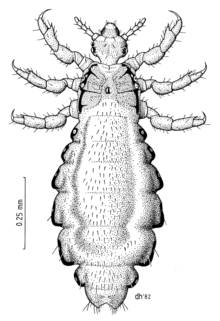
Back قمل الرأس Arabic قمل الراس ARZ Iko ATJ Kuto BCL Laou-penn Breton Poll del cap Catalan Veš dětská Czech Пуç пыйти CV Kpibiga DAG Kopflaus German
| Head louse | |
|---|---|

| |
| Scientific classification | |
| Domain: | Eukaryota |
| Kingdom: | Animalia |
| Phylum: | Arthropoda |
| Class: | Insecta |
| Order: | Psocodea |
| Family: | Pediculidae |
| Genus: | Pediculus |
| Species: | |
| Subspecies: | P. h. capitis
|
| Trinomial name | |
| Pediculus humanus capitis De Geer, 1767
| |
| Synonyms | |
|
Pediculus capitis (De Geer, 1767) | |

The head louse (Pediculus humanus capitis) is an obligate ectoparasite of humans.[1] Head lice are wingless insects that spend their entire lives on the human scalp and feed exclusively on human blood.[1] Humans are the only known hosts of this specific parasite, while chimpanzees and bonobos host a closely related species, Pediculus schaeffi. Other species of lice infest most orders of mammals and all orders of birds.
Lice differ from other hematophagic ectoparasites such as fleas in spending their entire lifecycle on a host.[2] Head lice cannot fly, and their short, stumpy legs render them incapable of jumping, or even walking efficiently on flat surfaces.[2]
The non-disease-carrying head louse differs from the related disease-carrying body louse (Pediculus humanus humanus) in preferring to attach eggs to scalp hair rather than to clothing. The two subspecies are morphologically almost identical, but do not normally interbreed. From genetic studies, they are thought to have diverged as subspecies about 30,000–110,000 years ago, when many humans began to wear a significant amount of clothing.[3][4] A much more distantly related species of hair-clinging louse, the pubic or crab louse (Pthirus pubis), also infests humans. It is morphologically different from the other two species and is much closer in appearance to the lice which infest other primates.[5] Louse infestation of the body is known as pediculosis, pediculosis capitis for head lice, pediculosis corporis for body lice, and phthiriasis for pubic lice.[6]
- ^ a b Buxton, Patrick A. (1947). "The biology of Pediculus humanus". The Louse; an account of the lice which infest man, their medical importance and control (2nd ed.). London: Edward Arnold. pp. 24–72.
- ^ a b Maunder, J. W. (1983). "The Appreciation of Lice". Proceedings of the Royal Institution of Great Britain. 55: 1–31.
- ^ Kittler R, Kayser M, Stoneking M (August 2003). "Molecular evolution of Pediculus humanus and the origin of clothing". Current Biology. 13 (16): 1414–7. doi:10.1016/S0960-9822(03)00507-4. PMID 12932325.
- ^ Stoneking, Mark (29 December 2004). "Erratum: Molecular Evolution of Pediculus humanus and the Origin of Clothing". Current Biology. 14 (24): 2309. doi:10.1016/j.cub.2004.12.024.
- ^ Buxton, Patrick A. (1947). "The crab louse Phthirus pubis". The Louse; an account of the lice which infest man, their medical importance and control (2nd ed.). London: Edward Arnold. pp. 136–141.
- ^ "pediculosis – Definition from the Merriam-Webster Online Dictionary". Retrieved 2008-04-23.
© MMXXIII Rich X Search. We shall prevail. All rights reserved. Rich X Search